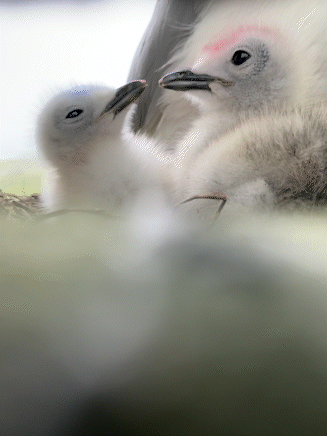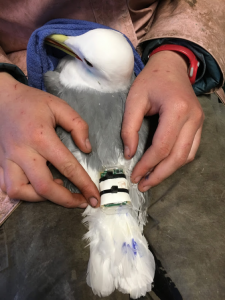
Ethogram for black-legged kittiwake (Rissa tridactyla) chick behaviors. Click here to access a detailed ethogram (for use with BORIS software) created by Bucknell graduate student Sierra N. Pete, MS’23 (with help from undergraduate Taiba Khan and Morgan Benowitz-Fredericks). Please cite Sierra’s thesis if you use this ethogram for your own work.
Benefits of short-term glucocorticoid elevations in young seabird chicks.
There is a lot of evidence that exposure to elevated glucocorticoids can impose long-term costs on developing birds, yet they retain the ability to secrete large quantities of corticosterone (the primary glucocorticoid in birds). Clearly, this response has been selected for. But the advantages of elevating corticosterone when you are young and your behavioral repertoire as a nest-bound chick is constrained are less clear. Glucocorticoids are understood to redirect physiology and behavior in ways that maximize fitness, and dogma has it that this usually involves mobilizing energy and increasing escape or feeding behaviors. Yet evidence for this is often generated by experiments that implant large quantities of exogenous corticosterone, overwhelming (or evoking) natural feedback mechanisms. This also overlooks the potential for important, rapid effects of corticosterone elevation. Black-legged kittiwake chicks can secrete massive quantities of corticosterone in response to 15 min of restraint just 5 days after hatching. Why?! Though tiny and fluffy, chicks at this age are capable of murderous aggression towards their siblings (“facultative siblicide”). We are investigating the immediate effects of brief elevations in corticosterone on physiology and behavior of free-living kittiwake chicks to better understand the role of glucocorticoids on short time scales.
Effects of food availability on physiology and behavior of Black-legged kittiwakes (Rissa tridactyla).
The opportunity to return to Middleton Island in the Gulf of Alaska in 2016 opened up an array of research questions about the role of food in the development, physiology and behavior of free-living seabirds. The infrastructure from the long-term food supplementation study at this site (initiated and maintained by Dr. Scott Hatch and Dr. Shannon Whelan through the Institute for Seabird Research and Conservation) provides minimally disruptive access to known-age breeding birds and their chicks, as well as the ability to manipulate food availability. We are interested in how food and the physiological challenges associated with reduced access to food at all life stages shape gene expression, physiology, behavior, reproductive strategies and survival in these marine top predators.
Impacts of genetic sex on parent:chick and sibling:sibling interactions.
Adult kittiwakes show distinct dimorphism based on genetic sex, as well as different levels of investment in different stages of reproduction. Visible dimorphism develops over the course of nestling period, but differences in physiology and behavior manifest before male and female chicks can be differentiated in terms of size. We are interested in a variety of questions related to the manifestation of sex differences in behavior and physiology. We are exploring how adults may respond differently to the demands of their male versus their female chicks, and how their own sex might influence this responsiveness (this project was developed by Steph Walsh, ’24, and is being continued by Maria Pisciotta, ’25 and Justley Sharp, ’27). We are also interested in how the sexes of chicks in multi-chick nests might affect behavior, physiology and survival, with particular attention to broods composed of same- versus different-sex chicks, as well as the sex of the first-hatched (“A chick”) versus the second-hatched (“B-chick”).
Relationships between social context and glucocorticoids in capuchin monkeys
Our lab recently began a rewarding collaboration with Bucknell colleague Dr. Reggie Gazes and her graduate students in the Animal Behavior Program – Andrew DeSana (MS’23) and Aiko Amano (MS’24) – to use salivary cortisol to explore relationships among social environment and endocrine physiology in a socially-housed colony of capuchin monkeys. Understanding how nuances and timing of social experiences might affect HPA axis activity will help understand the consequences of different types of social interactions, as well as help with interpretation of glucocorticoid data. Our first paper, led by Andrew, established some of the temporal dynamics of salivary cortisol in response to an acute stressor and lays the foundation for future projects.
